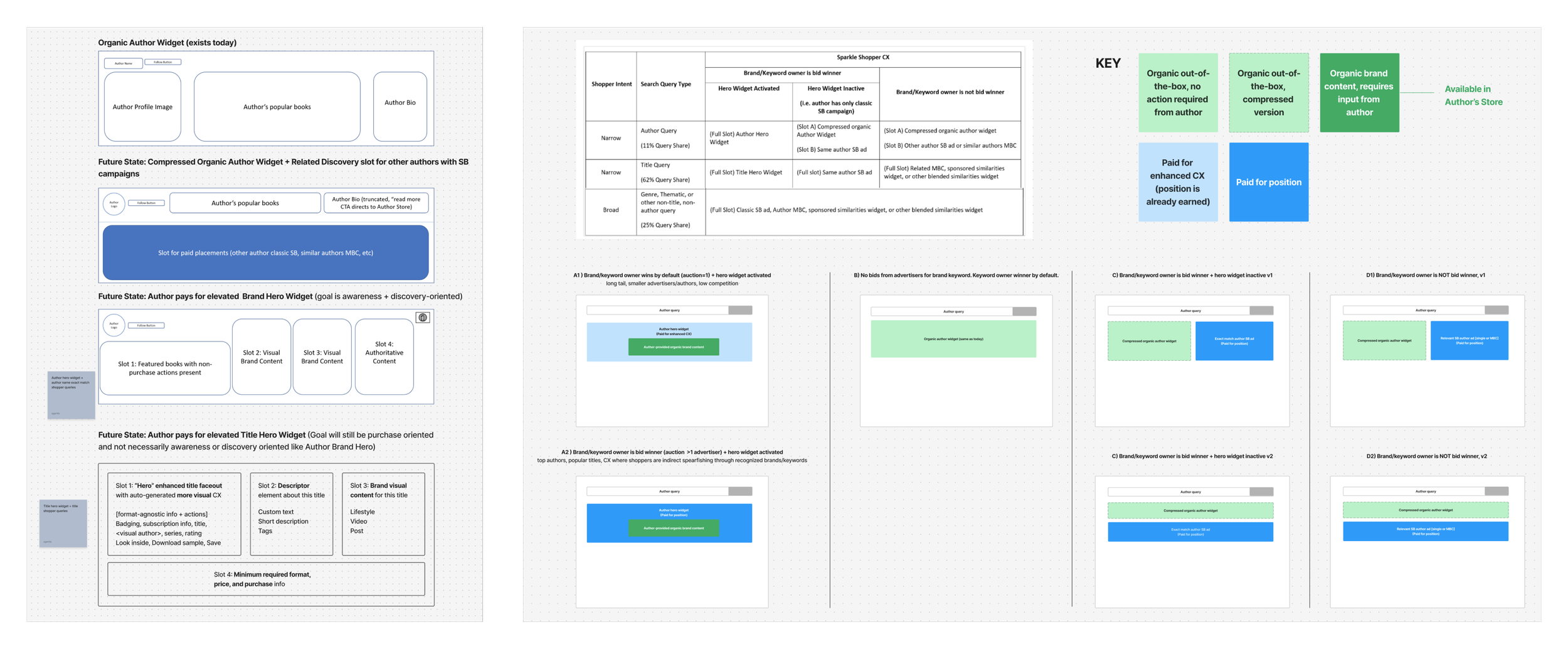Creating a books brand ads and monetization framework for top of search
Overview
A reimagined books top-of-search experience and monetization strategy, with a focus on author queries. ‘Marquee’ ads showcase an author’s brand and maximize visibility in Search, and enable shoppers to easily connect with authors and their books in-the-moment. When there’s competing demand, shoppers can explore similar authors — spinning the ads flywheel and meeting shopper, advertiser, and business needs.
Role
Design Lead — led UX vision and end-to-end process, from initial concept to experiment launch.
Played a key role in developing an ads strategy and creative framework with cross-category extensibility.
Team
Core team: 1 Principal PM, 5 FE and BE devs
Worked closely with cross-org partner teams throughout.
Defining the problem space
Shopper problems
Mismatched ads
In Books, 81% of searches are for a specific title or author name, but shoppers are often frustrated seeing a large ad for a different author in the top slot. Ads get in the way of the correct answer, introducing friction in these moments.
Limited author info
Shoppers expect more in author discovery and find author content to be informative and inspirational. Yet, ad creatives are product-forward and surface limited author-focused information to drive consideration — even in exact match circumstances.
Advertiser problems
Better brand building
A research synthesis revealed that advertiser brand building needs are unmet, with brand owners indicating Amazon doesn’t do enough to showcase their brands.
Banner blindness
Research showed top-of-search ads are affected by banner blindness, as shoppers have trained themselves to start discovery with the first organic result. Product-forward ads had only 34% visual engagement (vs 53% without an ad).
Voice of the customer (VOC)
“Irrelevant featured ads make it impossible to find what I want. I can literally type the author I want into search and the first books that come up are [other] sponsored ads”
“Amazon doesn’t have the same emphasis on brand that Facebook/Instagram has. We get small real estate to promote our brand”
Books discovery framework
When searching for a specific author, shoppers can have the intent to find that particular book (direct spearfishing), but also to use it as a jumping-off point to explore similar authors (indirect spearfishing). In a US study, ~56% of shoppers bought a different book title than the one they searched for on Amazon.
Author queries before
How might we reimagine the books top-of-search experience for author queries to work better for advertisers and shoppers?
Our goal: Provide advertisers with the ability to showcase their brand and maximize top of search visibility, while making author discovery easier for shoppers to meet their direct and indirect spearfishing needs.
Defining tenets
There’s high sensitivity and risks to shopper perception when irrelevant, top-slot ads get in the way of the correct answer and introduce friction in narrow intent shopping moments. This led my PM and I to establish a guiding shared tenet with our Books Retail partners: to always display the right answer first for author and title queries.
Defining the framework
Early exploration
In early stages, I visualized the beginning seeds of what the new top-of-search framework could look like. This explored how the intended CX mapped to different shopper inputs (narrow vs. broad), mapped to different advertiser goals (awareness/discovery vs. purchase), defining nuances of organic and paid content slots, and how to balance the information hierarchy between organic vs. paid content.
Refining for author queries
I refined how the framework would respond to different advertiser demand scenarios, while aligning to our mental model to be frugal with organic top-slot pixels. There were 3 main components: 1) a pixel-frugal organic ingress to the exact match author’s Store; 2) a medium slot for sponsored recommendations for similar authors; and 3) a large, premium ‘marquee’ ad for the exact match author.
Spinning the ads flywheel
The framework and monetization strategy we developed hits 3 key needs:
Shopper: Fulfill direct and indirect spearfishing needs.
Advertiser: Incentivizes author spend on brand defense ads to access new premium CX + connect with high-intent shoppers; AND incentivizes competitor spend to connect with potential readers — resulting in more purchases.
Business: Drives better ad performance and new advertiser demand.
Defining brand marquee content
It was important at in early stages to define how a new multi-card brand marquee ad would: 1) show authoritative information about a title or author, and 2) aggregate and prioritize content. The P0 content slots would display a mix of author-curated and auto-generated content from multiple sources. We prioritized advertiser-provided brand video and custom images, to respect the assets that authors provided during campaign creation. A personalized smart catalog would endcap the content cards, to help shoppers widen discovery to more of the author’s books.
Thinking holistically, we aimed for the same underlying framework to be extensible to both author and title queries.
Marquee ad design explorations
Early directions — author brand takeovers
Early directions proposed a heavily branded author ‘takeover’ concept, with custom background imagery and brand asset/color touches throughout. The mental model was to leverage the same underlying brand-centric framework for both title and author queries, enabling us to simplify dev efforts and accelerate future experimentation.
Simplifying and systemizing
As we refined to a more achievable P0 framework, I simplified and systemized — both for the authoritative header area, and each content slot. We narrowed in on content that authors already provided in existing systems, or was most likely to be available by our estimated launch date.
P0 scope + direction - responding to constraints
At this point, we decided to focus the initial experiment scope on author queries. The final P0 direction was impacted by a product requirements re-scoping and unanticipated technical challenges with integrating some of the originally-planned content slots (video, Posts, and smart catalog).
I evolved the P0 to lead with the custom image as the core branding element, a dynamic packaging of featured books in the campaign, and a flexible author book recommendation. I also concepted a new auto-gen end card, which aggregated valuable author info such as top genres, average book rating, and followers. This could be displayed for any author regardless of content availability.
P0 marquee card variations
The P0 marquee cards are able to flex depending on the content the author has provided, as well as how they’ve set up their ad campaign in the backend. The packaging of product ('ASIN’) cards is dynamic depending on the specific books an author wants to feature in the ad, and the total number included in the overall campaign. Author book recommendations can show an optional description.
Author Store ingress
Early explorations — balancing pixel frugality + our free offering
Initial directions for the free organic Author Store ingress had larger-sized elements and inclusion of Follow, biography, and book covers. While these were more ‘fully featured’, we hypothesized that they would still result in lack of advertiser incentive to bid on ‘marquee’ brand creatives.
I explored simplifying and minimizing to core elements, to still fulfill exact-match discovery needs while maintaining pixel frugality of this free slot.
Final direction - Author Store ingress
The final direction included starting P0 testing with a simple organic Store ingress link, and ramping to test ‘bolder’ versions with popular book covers and brand color in the future. Inclusion of ‘Follow’ was reserved for the paid marquee ad offering.
I explored options with an advertiser-provided custom image, but ultimately focused on solutions that could be auto-generated and would maximize scalability across most authors, regardless of their brand asset availability.
Multi-brand ads for similar authors
Early explorations — focusing on auto-generation
Initial directions for the multi-brand ads (‘MBC’) for similar authors had custom image backgrounds and top genre shown for each author. At this point, both custom images and top genre were scoped out for P0, and I explored alternate creatives that could be auto-generated using just book covers, author photo, and an auto-gen background color.
P0 direction - multi-brand ads for similar authors
The final P0 direction included testing with 2 treatments, to understand how inclusion of book covers in the ad creative may impact shopper engagement. At this point, a custom image started being required in all campaigns, so I re-focused the P0 CX to respect that required asset from advertisers as the core branding element.
To meet ads demand coverage for a P0 experiment, the CX also had to flex to accommodate campaigns from authors (promoting single author) as well as book publishers (promoting single author or multiple authors).
These multi-brand ads would always display paired with the organic Author Store ingress, to align with our tenet of exact-match answer first.
🚀 P0 experimentation
P0 experimentation is in-progress, with the scope targeting author queries. Milestone 1 testing is collecting data on performance of the new organic Store ingress and MBC ads. Milestone 2 will collect data on performance of the new author marquee ad.
Future vision and evolution
An adaptive approach
The long-term vision is to transition top-of-search ads from one-size-fits-all to a more adaptive approach. As more capabilities are launched for advertisers (e.g. vertical video, dynamic image aspect ratios), we plan to experiment with different layouts, pixel footprints, and content focus (brand-forward, product-forward) to align to advertiser intents and evaluate shopper propensity for interaction across different ad patterns.
Cross-category extensibility
We aimed for these solutions and proposed framework to be extensible beyond Books for all branded searches. Keeping extensibility in mind allows us to ideally scale these to all categories with minimal net-new engineering work. I worked closely and consulted with UX partners across teams (Ads, core Search) to ideate on cross-category extensibility of the marquee framework and creative experimentation sequencing.
We envisioned these creatives to evolve to be flexible across various advertiser objectives (e.g. drive visits to Detail Page) and shopper outcomes (e.g. when we have shopper signal for product-focused intent).
A holistic creative formats framework
This work informed the development of a component-based creative ad framework, which adapts to shopper signals and outputs personalized creative formats that resonate with shoppers at key moments in their journey.
Marquee ads, for example, adapt content based on the shopper’s search query and their previous propensity with the brand. The framework considers various signals like the shopper’s relationship with the brand, their browsing and purchase history, and content attributes that help build customer trust.










































